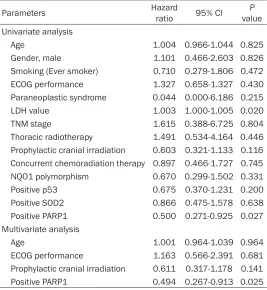Original Article Clinical significance of NQO1 polymorphism and expression of p53, SOD2, PARP1 in limited-stage small cell lung cancer
Full text
Figure




Related documents
Hemorrhagic manifestations in dengue infection seen clinically are petechiae, echymosis, purpurae, hematuria, hemoptysis, subconjunctival hemorrhages, epistaxis, hematemesis,
The reaction mixture containing amide, Buffer solution, catalyst was allotted to equilibrate for half an hour, after which the bromamine-T solution was added to initiate
For this purpose, we have employed the semiclassical gravity theory based on the WDW equation and provided the semiclassical gravity for a pure gravity with the LG transforma-
We measured changes in physician self-efficacy, physi- cian communication practices, patient health status and health care utilization for asthma, and visit time for asthma primary
This document sets out the regulations where it has been assessed that the provider or person in charge are not compliant with the Health Act 2007 (Care and Welfare of Residents
When periodontal infections or dental extractions lead to BP-ONJ of the dorsal maxilla, an involvement of the maxillary sinus is not unlikely: 40 – 50 % of the patients with a
The objective of the present study is the efficacy of the drug in decreasing IOP, maintenance efficacy of the visual field, and to investigate the safety of long-term
Only few fungal strains (mainly Aspergillus terreus) have been used for industrial scale production of statin molecules (mainly lovastatin and simvastatin). Finding
